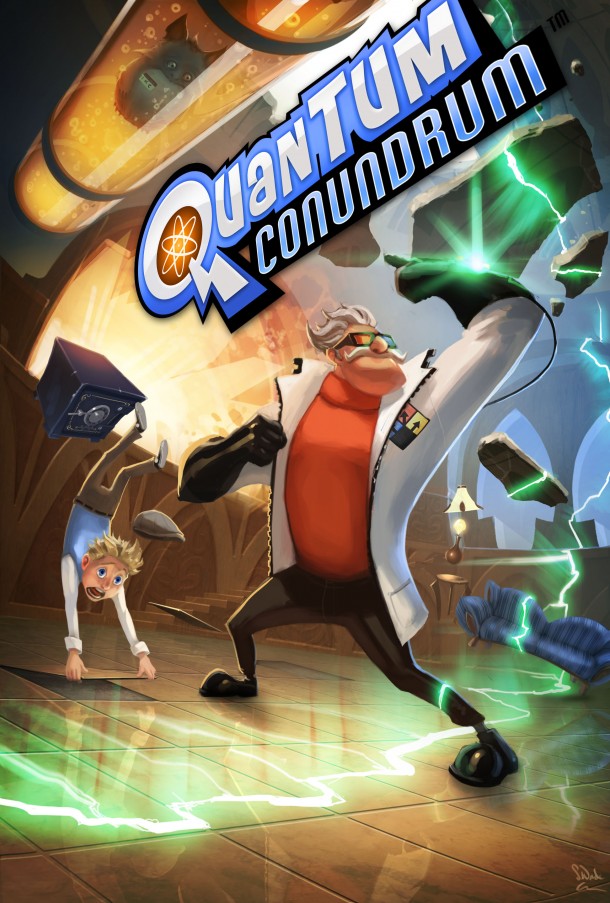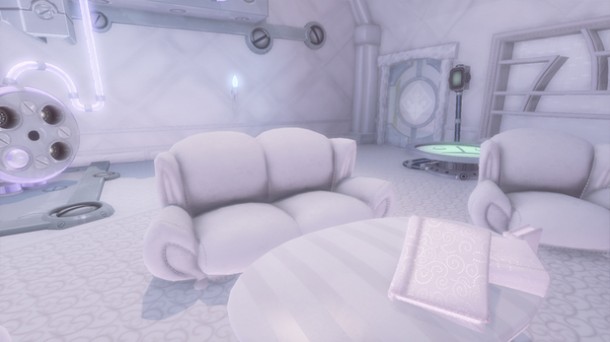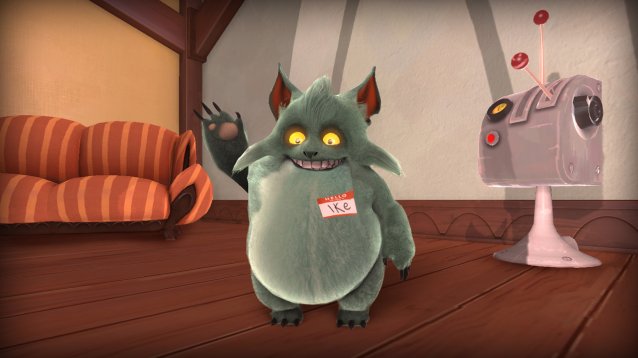 Quantum Conundrum is not Portal, no matter how much it wants to convince you otherwise. A first-person physics puzzler with a quirky narrator, goofy science gags and designed by Valve alum Kim Swift, it’s obvious that the comparisons are striking.
Quantum Conundrum is not Portal, no matter how much it wants to convince you otherwise. A first-person physics puzzler with a quirky narrator, goofy science gags and designed by Valve alum Kim Swift, it’s obvious that the comparisons are striking.
Luckily for developer Airtight Games, it’s also a hell of a lot of fun.
If you haven’t been keeping up, Quantum Conundrum is all about dimensions. Specifically, it’s all about switching between four parallel dimensions including fluffy, heavy, slow-motion and anti-gravity in order to solve physics puzzles and platforming challenges. There is a story involving a young, silent protagonist and his arrogant, high-thinking uncle, Professor Quandwrangle, portrayed by John de Lancie (or as I like to call him, Q the Narrator) but it’s largely unimportant to what amounts to the core of the game’s experience.
In fact, that’s probably my biggest issue with Quantum Conundrum. The world, story and characters all feel almost like an afterthought. John de Lancie is always fun and as I mentioned he’s just about one stupid hat short of being in full Q mode throughout the five hour campaign, but nothing else seems to be worth noting. The story is highly non-adversarial with none of the cynicism you’d get from games like, say, a Telltale game.
In a way, that’s kind of refreshing. It’s nice to know that some games are willing to take a break from the ridiculous melancholy of the majority of ‘serious’ game narratives while still avoiding the constant stream of irony that seems to have supplanted most real attempts at video game humor.
Unfortunately, what’s left feels as though the developers stripped away all expectations so as not to draw too many comparisons to Swift’s previous work and simply forgot to put anything else in their place. There are a few silly sidelines involving the Professor’s past experiments and his inter-dimensional sidekick/pet Ike as well as the history of the Quadwrangle family, but they do little more than elicit the occasional chuckle.
Occasionally, the game’s graphical style attempts to make up for the lack of narrative punch. Switching between dimensions will produce the rare sight gag by morphing the environment’s aesthetic. For example, switching to Heavy dimension will cause your surroundings to become harder, darker and more metallic — looking something like the Hell world from Silent Hill. When this happens, any wall mounted portraits of the Quadwrangle family that happen to be present will alter to match the new look. Suddenly, that painting of a stuffy, British officer will look like an extra in a Judas Priest video or become extra cute and cuddly or… Well, you get the idea.

It’s a very neat idea, if heavily underutilized. As you progress through the game, it seems that less and less of the environment noticeably shifts with its new dimension. Add to that that two of the four dimensional options don’t actually change the environment at all and the fact that you’ll be switching between them so often and so quickly that all of the changes begin to blur together and you may cease noticing it altogether.
Meanwhile, the shell that is the game’s default ‘silly science’ aesthetic that remains serves only to awkwardly remind you that, yes, this is enough like Portal so that you know it’s pedigree without just ripping off its personality… By having very little of its own.
Putting all of that to one side for a moment, I’d like to point out one very important way in which Kim Swift’s involvement seems to make a positive impact. And that is that the design of the puzzles and levels is absolutely pristine.
I encountered fewer instances where I found myself completely stumped as to how to progress in the half a dozen hours of my first playthrough than hours of gameplay. As someone who is often turned off by these sorts of games precisely because he isn’t very good at finding necessary puzzle solutions, I must say that I was impressed by how quickly I could suss out a given situation.
It could be argued that Quantum Conundrum is simply an easy game. However, after switching to fluffy dimension to pick up a couch, tossing it into the air, switching to slow-motion so that I might jump on top of it, feathering anti-gravity to fly between oscillating lasers, switching to heavy dimension in time to avoid having it disintegrated and then jumping to another sofa and repeating the process in mid-air, I would have to disagree. Rather, I think that it is a testament to the airtight design (pun 100% intended) of Swift and the dev team for crafting what should have, for me, been a very frustrating experience into something that made me feel instead like a mental god. Though, I must admit that the mechanics of perfectly jumping in first-person (when I can see neither my characters feet nor head) still occasionally eluded me.
Quantum Conundrum may not be the revelation that Portal was — even if it feels like, in many ways, trying to be. The gameplay is smooth and has real depth, but the world never fails to fall flat. That doesn’t change the fact that it’s a fun, tightly designed physics puzzler that had me caught in the “just one more level” trap like a feedback loop.
This review is based off of a copy of the game sent to SideQuesting by the publisher.



No Comments